Under Pope Pius XII, there were the several reforms of Catholic Eastern canon law applying to the Eastern Catholic Churches.
 |
| Part of a series on the |
| Canon law of the Catholic Church |
|---|
| |
Under Pope Pius XII, there were the several reforms of Catholic Eastern canon law applying to the Eastern Catholic Churches.
A commission was established in 1929 by Pius XI to draw up a schema for an Oriental Catholic canon code, [1] [2] the Commissionem Cardinalitiam pro Studiis Praeparatoriis Codificationis Orientalis. [3] In 1935, the same pope established another commission with the same goal, the Pontificia Commissio ad redigendum Codicem iuris canonici orientalis, to replace the former. [4]
The Eastern Catholic Churches, not unlike the Latin Church before the Code of 1917, had their own ancient laws, which were not codified. Some reforms of Eastern Church laws for the Eastern Churches were done during the pontificate of Pius XII. The new Church canons promulgated by Pius XII for the government of the Eastern Catholic Churches concern matrimonial law, [5] Church trials, [6] administration of Church properties and religious orders [7] and individual rights. [8]
After World War II, a new situation developed as millions of united Christians from Eastern Europe and the Middle East emigrated to the West: United States, Western Europe, Canada, South America, and Australia. The new Church law was welcomed, yet in some points, it was critiqued, for not fully adopting to these new Western circumstances. Traditionally, Eastern Christians insisted on legal exemptions, allowing them to keep most of the ancient customs and laws. [9]
Pope Pius XII stated in his encyclical Mystici Corporis Christi those reforms were intended to establish Eastern Catholics as equal parts of the Catholic Church. [10]
These individual canon law reforms of Pope Pius XII were revised in 1991. The Code of Canons of the Eastern Churches for members of the Eastern Catholic Churches were promulgated on 18 October 1990 by Pope John Paul II and came into effect on 1 October 1991. [11]
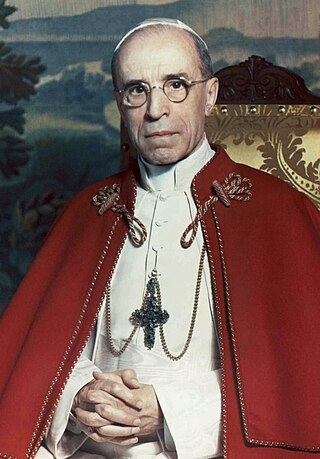
Pope Pius XII was head of the Catholic Church and sovereign of the Vatican City State from 2 March 1939 until his death in October 1958. Before his election to the papacy, he served as secretary of the Department of Extraordinary Ecclesiastical Affairs, papal nuncio to Germany, and Cardinal Secretary of State, in which capacity he worked to conclude treaties with various European and Latin American nations, including the Reichskonkordat treaty with the German Reich.
Code of Canon Law may refer to:
Mystici Corporis Christi(The Mystical Body of Christ) is an encyclical issued by Pope Pius XII on 29 June 1943 during World War II. Its main topic is the Catholic Church as the Mystical Body of Christ.
Acta Apostolicae Sedis, often cited as AAS, is the official gazette of the Holy See, appearing about twelve times a year. It was established by Pope Pius X on 29 September 1908 with the decree Promulgandi Pontificias Constitutiones, and publication began in January 1909. It contains all the principal decrees, encyclical letters, decisions of Roman congregations, and notices of ecclesiastical appointments. The laws contained in it are to be considered promulgated when published, and effective three months from date of issue, unless a shorter or longer time is specified in the law.
The Code of Canons of the Eastern Churches is the title of the 1990 work which is a codification of the common portions of the canon law for the 23 Eastern Catholic Churches in the Catholic Church. It is divided into 30 titles and has a total of 1546 canons. The code entered into force in 1991.
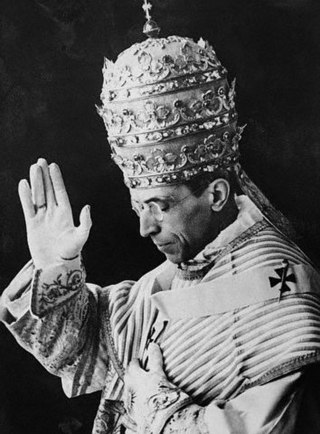
Summi Pontificatus is an encyclical of Pope Pius XII published on 20 October 1939. The encyclical is subtitled "on the unity of human society". It was the first encyclical of Pius XII and was seen as setting a tone for his papacy. It criticizes what it saw as major errors of the time, such as ideologies of racism, cultural superiority, and the totalitarian state. It also sets the theological framework for future encyclical letters such as Mystici corporis Christi (1943). The encyclical laments the occupation of Poland, denounces the Molotov–Ribbentrop Pact, and calls for a restoration of independent Poland.
The canon law of the Catholic Church is "how the Church organizes and governs herself". It is the system of laws and ecclesiastical legal principles made and enforced by the hierarchical authorities of the Catholic Church to regulate its external organization and government and to order and direct the activities of Catholics toward the mission of the Church. It was the first modern Western legal system and is the oldest continuously functioning legal system in the West, while the unique traditions of Eastern Catholic canon law govern the 23 Eastern Catholic particular churches sui iuris.
Orientales ecclesias is an encyclical of Pope Pius XII concerning the persecution of the Eastern Catholic Churches and describing the desperate situation of the faithful in Communist Bulgaria.
Pope Pius XII and Russia describes relations of the Vatican with the Soviet Union, Russia, the Eastern Orthodox Church, and the Eastern Catholic Churches resulting in the eradication of the Church in most parts of the Soviet Union during the Stalinist era. Most persecutions of the Church occurred during the pontificate of Pope Pius XII.
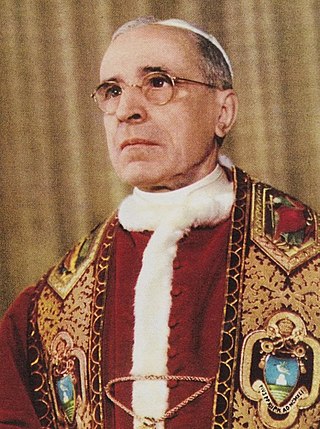
The late years of the pontificate of Pope Pius XII were characterized by a hesitancy in personnel decisions. After a major illness in 1954, he redirected his energies from Vatican clergy to the concerns of lay people.
Sebastiaan Peter Cornelis Tromp was a Dutch Jesuit priest, theologian, and Latinist, who is best known for assisting Pope Pius XII in his theological encyclicals, and Pope John XXIII in the preparation for Vatican II. He was an assistant to Cardinal Alfredo Ottaviani during the Council and professor of Catholic theology at the Pontifical Gregorian University from 1929 until 1967.

Ad Caeli Reginam is an encyclical of Pope Pius XII, given at Rome, from St. Peter's Basilica, on the feast of the Maternity of the Blessed Virgin Mary, the eleventh day of October, 1954, towards the end of the Marian year, in the sixteenth year of his Pontificate. The encyclical is an important element of the Mariology of Pope Pius XII. It established the feast Queenship of Mary.

Fulgens corona is an encyclical by Pope Pius XII, given at St. Peter's, Rome, on 8 September 1953, the Feast of the Nativity of the Blessed Virgin Mary, in the fifteenth year of his Pontificate. The encyclical proclaims a Marian year for 1954, to commemorate the centenary of the definition of the dogma of the Immaculate Conception of the Virgin Mary.

The theology of Pope Pius XII is reflected in his forty-one encyclicals, as well as speeches and nearly 1000 messages, during his almost 20-year pontificate. The encyclicals Mystici corporis and Mediator Dei advanced the understanding of membership and participation in the Catholic Church. The encyclical Divino afflante Spiritu began opening the door to historical-critical biblical studies. But his magisterium was far larger and is difficult to summarize. In numerous speeches Catholic teaching is related to various aspects of life, education, medicine, politics, war and peace, the life of saints, Mary, the mother of God, things eternal and temporal.

The Mariology of the popes is the theological study of the influence that the popes have had on the development, formulation and transformation of the Roman Catholic Church's doctrines and devotions relating to the Blessed Virgin Mary.
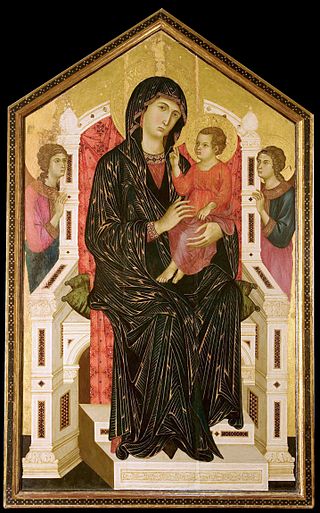
Mariological papal documents have been a major force that has shaped Roman Catholic Mariology over the centuries. Mariology is developed by theologians on the basis not only of Scripture and Tradition but also of the sensus fidei of the faithful as a whole, "from the bishops to the last of the faithful", and papal documents have recorded those developments, defining Marian dogmas, spreading doctrines and encouraging devotions within the Catholic Church.
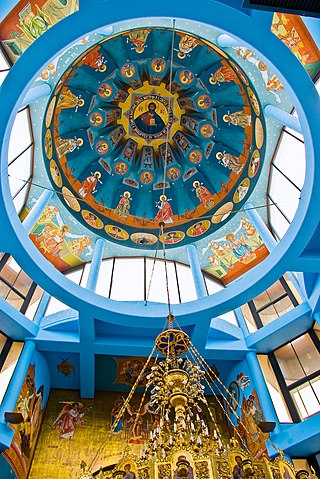
Eastern Catholic victims of Soviet persecutions include bishops and others among the tens of thousands of victims of Soviet persecutions from 1918 to approximately 1980, under the state ideology of Marxist–Leninist atheism.
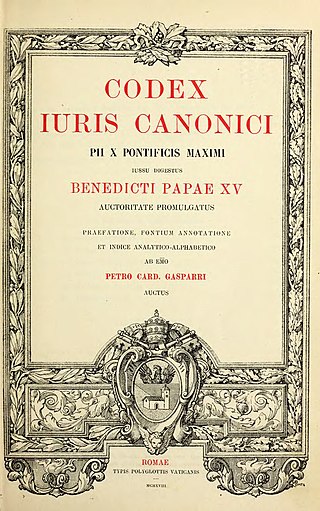
The 1917 Code of Canon Law, also referred to as the Pio-Benedictine Code, is the first official comprehensive codification of Latin canon law.
The Catholic Church utilizes the oldest continuously functioning legal system in the West, much later than Roman law but predating the evolution of modern European civil law traditions. The history of Latin canon law can be divided into four periods: the jus antiquum, the jus novum, the jus novissimum and the Code of Canon Law. In relation to the Code, history can be divided into the jus vetus and the jus novum. Eastern canon law developed separately.
The Eastern Catholic canon law is the law of the 23 Catholic sui juris (autonomous) particular churches of the Eastern Catholic tradition. Eastern Catholic canon law includes both the common tradition among all Eastern Catholic Churches, now chiefly contained in the Code of Canons of the Eastern Churches, as well as the particular law proper to each individual sui juris particular Eastern Catholic Church. Oriental canon law is distinguished from Latin canon law, which developed along a separate line in the remnants of the Western Roman Empire, and is now chiefly codified in the 1983 Code of Canon Law.